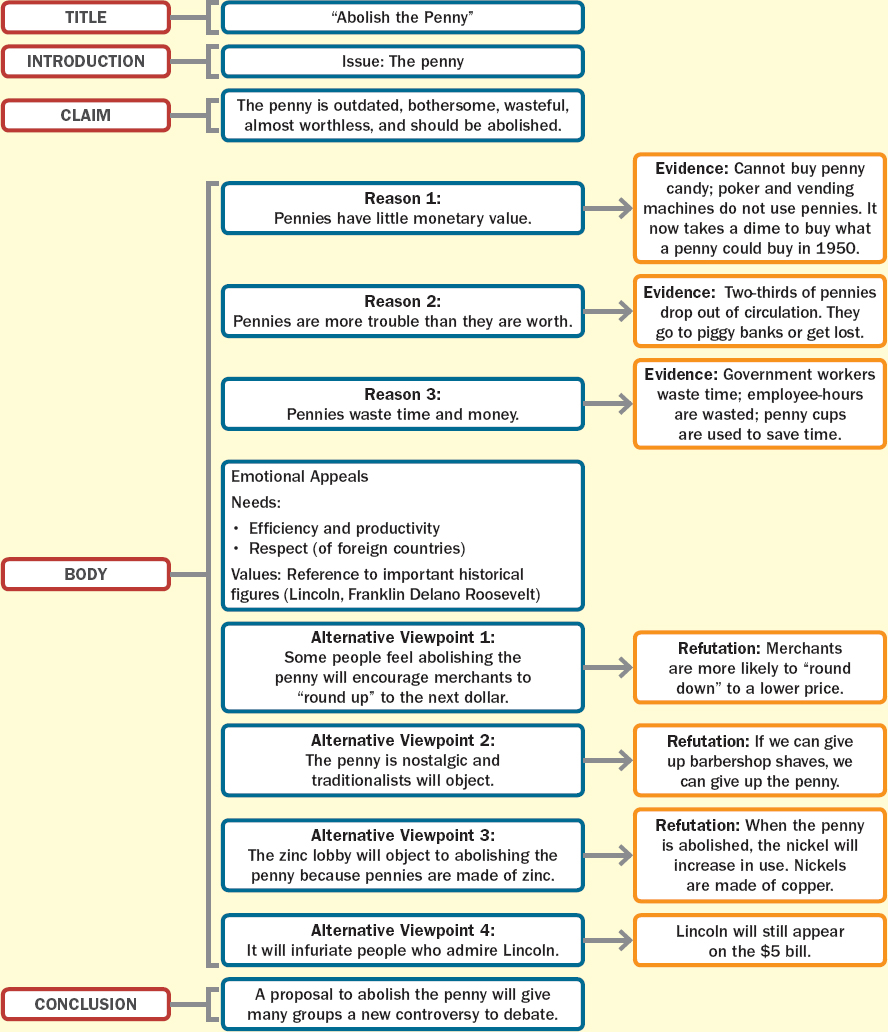“Abolish the Penny” William Safire
READING
Abolish the Penny
WILLIAM SAFIRE
William Safire (1929–2009), a former speechwriter for President Richard Nixon and Vice President Spiro Agnew, was a longtime political columnist for The New York Times. He was also well known for “On Language,” his column on grammar, usage, and etymology in the weekly New York Times Magazine, and he published many books, including novels, collections of his columns, and Before the Fall: An Inside View of the Pre-Watergate White House (2005). He won the Pulitzer Prize for commentary in 1978. As you read the following essay, published in 2004, notice how Safire gives his own reasons for abolishing the penny and anticipates possible counterarguments.
Because my staunch support of the war in Iraq has generated such overwhelming reader enthusiasm, it’s time to reestablish my contrarian credentials. (Besides, I need a break.) Here’s a crusade sure to infuriate the vast majority of penny-pinching traditionalists: The time has come to abolish the outdated, almost worthless, bothersome, and wasteful penny. Even President Lincoln, who distrusted the notion of paper money because he thought he would have to sign each greenback, would be ashamed to have his face on this specious specie.
1
That’s because you can’t buy anything with a penny any more. Penny candy? Not for sale at the five-and-dime (which is now a “dollar store”). Penny-ante poker? Pass the buck. Any vending machine? Put a penny in and it will sound an alarm. There is no escaping economic history: it takes nearly a dime today to buy what a penny bought back in 1950. Despite this, the U.S. Mint keeps churning out a billion pennies a month.
2
Where do they go? Two-thirds of them immediately drop out of circulation, into piggy banks or—as the Times’s John Tierney noted five years ago—behind chair cushions or at the back of sock drawers next to your old tin-foil ball. Quarters and dimes circulate; pennies disappear because they are literally more trouble than they are worth. The remaining 300 million or so—that’s 10 million shiny new useless items punched out every day by government workers who could be more usefully employed tracking counterfeiters—go toward driving retailers crazy. They cost more in employee-hours—to wait for buyers to fish them out, then to count, pack up, and take them to the bank—than it would cost to toss them out. That’s why you see “penny cups” next to every cash register; they save the seller time and the buyer the inconvenience of lugging around loose change that tears holes in pockets and now sets off alarms at every frisking place.
3
Why is the U.S. among the last of the industrialized nations to abolish the peskiest little bits of coinage? At the G-8 summit next week, the Brits and the French—even the French!—who dumped their low-denomination coins thirty years ago, will be laughing at our senseless jingling. The penny-pinching horde argues: those $9.98 price tags save the consumer 2 cents because if the penny was abolished, merchants would “round up” to the nearest dollar. That’s pound-foolish: the idea behind the 98-cent (and I can’t even find a cent symbol on my keyboard any more) price is to fool you into thinking that “it’s less than 10 bucks.” In truth, merchants would round down to $9.95, saving the consumer billions of paper dollars over the next century.
4
What’s really behind America’s clinging to the pesky penny? Nostalgia cannot be the answer; if we can give up the barbershop shave with its steam towels, we can give up anything. The answer, I think, has to do with zinc, which is what pennies are mostly made of; light copper plating turns them into red cents. The powerful, outsourcing zinc lobby—financed by Canadian mines as well as Alaskan—entices front groups to whip up a frenzy of save-the-penny mail to Congress when coin reform is proposed.
5
But when the penny is abolished, the nickel will boom. And what is a nickel made of? No, not the metallic element nickel; our 5-cent coin is mainly composed of copper. And where is most of America’s copper mined? Arizona. If Senator John McCain would get off President Bush’s back long enough to serve the economic interests of his Arizona constituents, we’d get some long-overdue coin reform.
6
What about Lincoln, who has had a century-long run on the penny? He’s still honored on the $5 bill, and will be as long as the dollar sign remains above the 4 on keyboards. If this threatens coin reformers with the loss of Illinois votes, put Abe on the dime and bump F.D.R.
7
What frazzled pollsters, surly op-ed pages, snarling cable talkfests, and issue-starved candidates for office need is a fresh source of hot-eyed national polarization. Coin reform can close the controversy gap and fill the vitriol void. Get out those bumper stickers: Abolish the penny!
8
